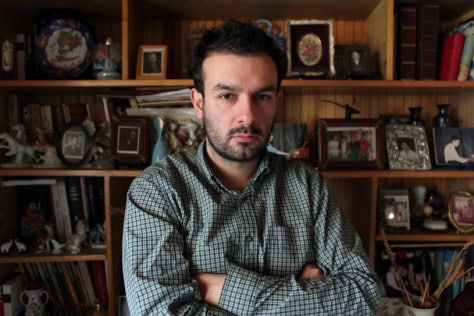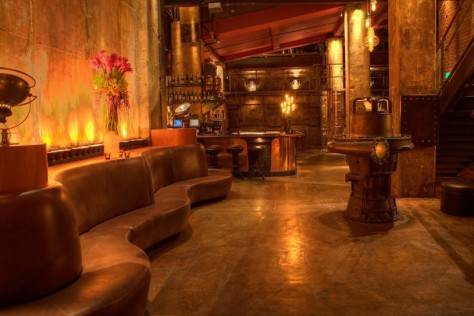Rusting railings rattle in the freezing wind as lorries shudder past along a floodlit quay; pedestrians are bathed in hellish amber light, their excited voices drowned beneath the humdrum of industry. Pugnacious locals, possessed of the ill humour of the unemployed, loiter with intent, contemplating violence against the club kids in their midst. On any routine Scotch night this clash of blue collars and lace ruffles would predictably end in a carnage of black eyes, broken heels and flayed sequins, yet this evening our beleaguered fashionistas have Gareth Pugh and his frightfully “fierce” entourage as their custodians.
Here in Glasgow, a bitter 400 miles north of London, itself the world’s most northerly fashion capital, are deployed his high-gloss shock troops. They stand immovable, elevated in platform combat boots, their patent-leather-encased torsos glistening darkly beneath mantles of the whitest fur. Thus, monochrome guards ring the old Comme Des Garcons store, its derelict shell a testament to the backwardness of Scottish fashion. These acolytes have conveyed Pugh from London, their very clothes trophies of the city’s campaign to become fashion’s New Jerusalem. London has neither Paris’ haute couture, New York’s buyers nor Milan’s textiles, yet it has played midwife to Galliano, Westwood, McQueen and now an Anna Wintour-approved enfant terrible, the latex-swaddled Gareth Pugh.
Tonight’s exposition is the work of London’s demimonde-beating club night, BoomBox. Forget the now-defunct MisShapes, this is the throbbing heart of style innovation. The evening’s shock invasion of a grim Scotch customs warehouse illustrates the eccentricity of both designer and club vehicle, the equivalent of Zac Posen and his Gramercy Park set braving the industrial wilds of Detroit. Pugh’s favorite club haunt launched its photo album at October’s Paris Fashion Week, won Suzy Menkes’ support in Milan last year and hosted Pugh’s after-show party in London. That night is now notorious for Kylie Minogue’s adventures on the wheels of steel and her dancing on the thronged bar, all the while clad precariously in a Pugh tasselled leather dress. Even here on this drab Glasgow night, the club’s infectious, raw excitement seethes through a celebrity-bereft wasteland of cavernous warehouses and treacherous cobbled alleys. Here is a cityscape reminiscent of Pugh’s native Sunderland, another sinister and urban sprawl, infamous for its soccer hooliganism and the asphyxiation of nearly 200 of its children in the crowded stairwells of Victoria Hall.
Sacrificing warmth for style, Pugh shivers obstinately in a monochrome jersey. Casting a proud gaze at his cohorts, formed up haphazardly outside tonight’s venue, he extols the virtues of his relocation to London. “In Sunderland you have to fit into a certain sort of person to just exist there. Where I come from, if you’re an outsider, people won’t respect you at all. They’ll think you’re a freak,” he says. “I got off the train coming from London in Sunderland and there was this woman with a pram who said, “Oh, is that a man or a woman?” I wasn’t dressed up or anything; I was just in day wear. It’s the sort of thing you just put up with and it’s never going to change. That’s why London’s such a Mecca.”
Pugh’s pilgrimage began at Central Saint Martins, the school that spawned Heidi Slimane, Zac Posen, Galliano and Stella McCartney, among others. Co-opted first into TV’s Fashion House, talent foundation Fashion East then asked Pugh to exhibit in its autumn 2005 London Fashion Week showcase. “I was called up four weeks before the deadline and I wasn’t going to say no to showing at London Fashion Week, so I busted my arse to do a show,” Pugh explains. From that auspicious debut his rise was meteoric, yet only last September did serious production start. “That was my first show and I designed for Kylie [Minogue] straight afterward. Then all of a sudden it was my next show. For the past four or five shows it was all for the show and nothing was ever made. The clothes just went straight to being reserved for press.” Style-savvy exquisites around the world cried out for the chance to buy Pugh’s creations, yet the few pieces in existence, all handmade in Pugh’s run-down East London studio, were off-limits to all but the most renowned stylists and even then only on loan.
The start of Pugh’s production lines is hotly anticipated by fashion cadres from New York to Milan. His use of parachute silk, patent boot leather, afro-weave synthetic hair, fur, electrically charged plastic and, last fashion week, a stole made of stuffed white mice, has set hearts aflutter on both sides of the Atlantic. Are his clothes a reaction to persecution, tonight’s Glaswegian parade a stylized blitzkrieg against narrow-minded northern Brits? “My clothes are very aggressive, sharp and very strict, but that’s not a reaction. That’s just the aesthetic that I really like, and it seems to me that it really fits with what is going on at the minute. It’s not a personal statement,” Pugh says. Does he then hope that as London’s creativity has diffused to the provinces, chavs will swap their bleached jeans for PVC leggings? Will we see legions of teens faceless in burnished PVC and oversized cashmere? “That’s not my aim. I aim to inspire people and show them something interesting. I don’t want be like Armani. I don’t want to be like Primark.”
He also takes issue with PVC, the cheapness of which appears to rankle him. “I only really make leggings out of PVC. That dress is patent leather—it’s boot leather,” he says, gesticulating toward his 32-hole lace-up leather boots. “I’ve also worked with Kopenhagen Fur. Fox is nice because it has the volume, but for the next show we’re doing, everything is going to be in mink. It’s so luxurious.” Indeed, one only has to glance at the craftsmanship of Pugh’s clothes to be reminded of the great Parisian houses; such innovation both in use of fabric and elegance of cut is usually the preserve of the Chambre Syndicale de la Haute Couture.
In the context of Boombox and its hordes of Pugh devotees, however, the designer himself feels misapprehended. “I get very annoyed when people class me as a club-kid designer, because my clothes are made to be worn in better places than clubs,” he says. “My clothes aren’t meant to be for some sort of backroom East London drinking hole.”
Pugh is now approaching a common conundrum for small designers—often the only way to reach a wide audience is by relying on another company’s production apparatus, a process that is fraught with compromise. “You can go Leigh Bowery’s [a seminal 80s–90s fringe designer and performer] way where it’s all about the artistry of it or you can do fashion and sell clothes. When I started off I was just doing what I was doing because I fell into doing it, but at some point I want to have people in my studio, and I want to be able to pay the people I work with.” Has he been approached? “Topshop asked me a long time ago to do something with them. They wanted me to do a capsule for their shop on Oxford Street. That wasn’t right because I wasn’t actually selling my own stuff then. It would have been before my actual main line came out. There are a lot of people I potentially could work with, and it would be amazing. But they would have to take a risk to have the integrity to do something with me. A lot of companies want to play it safe and do it with somebody who does something quite beautiful and quite sellable and brand marketable, whereas I don’t necessarily do something that is accessible to a broad range of people. There’s the high street and the pages of Grazia, and I’m not a regular feature on those—but that’s fine by me.”
The evening has turned. A forbidding wind gusts off the North Sea while the local ruffians test the perimeter of the designer’s oasis of freedom. Pugh’s PR beckons him inside, shielding him against an inclement night and provincial prejudice. Hardship is, however, not something the deceptively fragile-looking Pugh is shy of.
“It’s a double-edged sword,” he explains. “If I did things that were a bit more accessible, I would have a lot more money jobs, but at the end of the day I’m happy with what I’m doing, and I’m making enough to support what I am doing. I don’t really feel the need to have expensive clothes and a car. All I need is the money to pay for the things I need.”
Observing Pugh the next month at a Paris Fashion Week party, I witnessed instead a feted figure gazed at with wonderment by the habitually insouciant Parisian glitterati and caressed lovingly by a cat-suited Agyness Deyn. That hardly constitutes a life of deprivation, surely?
 Q&A with Larry Gus
Q&A with Larry Gus We Own the Night: The Edison
We Own the Night: The Edison
No Comments